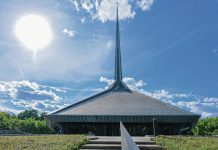Columbus is moving forward with a major project for Columbus and Bartholomew County’s Bicentennial.
The Columbus Redevelopment Commission has selected Hitchcock Design Group and American Structurepoint to complete the preliminary design phase for the Bicentennial 1821 Trail with a not-to-exceed amount of $81,700.
Redevelopment director Heather Pope said that the two firms decided to partner together. Hitchcock is the lead designer for the riverfront project, and American Structurepoint is the lead design on the multifamily urban grocer project being developed by Flaherty & Collins.
“They can come to this project with a lot of knowledge already,” she said. “So Hitchcock Design Group has the plans for the west side, and Flaherty & Collins will have the plans for the east side. So how those trails intersect and connect to those two separate projects, that work’s kind of already been done. So we feel like there’s some savings there.”
Pope said that this agreement is just for the design and schematic design phase of the project and includes a fixed fee of $79,700.
She said that this first phase will include interviewing “key stakeholders” such as the historical society and the bicentennial committee, gathering information, and creating a design, based on their findings, for “how to best represent the last 200 years of Columbus and Bartholomew County.”
“And then, from there, they will provide a schematic design,” Pope said. “And at that point, we need to decide whether we’re going to move forward, what we’re going to take away from the project or add to the project. But we really won’t know a true cost estimate until the schematic design is completed.”
She said that in addition to a schematic design and cost estimate, the design firms will also develop a phasing strategy and illustrative graphics for fundraising.
Funding sources for the project will include the Parks Foundation, Columbus Redevelopment and private donors. Pope said that the Parks Foundation has agreed to give $250,000 toward the construction of the project.
The overall project may come in at a higher bill than anticipated, said Dave Hayward, city engineer and executive director of public works. He said that when the city asked engineers and architects to design the project and estimate its cost, they were given a higher estimate than originally expected.
“We were thinking this was about a $1 million project, and they think it’s a little higher than that,” he said. “So we’ve got our work cut out for us. We either need to come up with more money, or cut the project back to the point that we need to to make it fit the budget.”
Pope said that the city hopes to do some “value engineering” once a design is created and then cut the project back to fit the budget.
“But we also don’t want to skimp on this project,” she added. “This is our bicentennial project, and we want to celebrate it.”
Executive Director of Administration and Community Development Mary Ferdon said that the city is going to private donors for certain elements and “extras” in the project. She said that if redevelopment’s contribution ends up being limited, “We will build to our budget.”
“The reality is, we will spend what we have and do what we can,” said Ferdon. “And if we have to phase it, we will. Or it might be very basic, and then we can add some of the features as we can find the monies to.”
Work on the project will likely not begin until this fall.
“We’re looking forward to getting started,” Hayward said. “If you’re wondering when we’re going to get it built, we don’t really think we can start before Labor Day because of the farmers’ market down there.”
The timeline of the project will depend on how much of First Street may be closed down at a time. If the entire street could be closed at the same time, it could be done more quickly. However, it’s more likely that one or two of the intersections will be closed at a time.
He said that three to four months seems like a “reasonable” estimate for how quickly the project can be done.
“It all depends on how busy contractors are,” he added. “There’s a lot of variables.”
Ferdon said that the city believes the 1821 Trail will be a “very important amenity” for residents and visitors alike.
“Over the past year, we have seen more use of the People Trail throughout the city than probably ever in the history of the People Trail,” she said. “And we’ve made it a priority to keep them open and available. And we think the community has appreciated that. And we feel the positive impact it’s had on the community’s mental health is something that you can’t ever understate.”
[sc:pullout-title pullout-title=”About the project” ][sc:pullout-text-begin]
The Bicentennial Commission and City of Columbus announced in February that the seminal project for the Columbus Area Bicentennial will be the 1821 Trail extension along First Street, from the Haw Creek Trail, which ends at Lafayette Street, to Water Street. This trail extension will also include architectural and art elements to encompass the 2021 Bicentennial theme of “Common Ground.”
It is estimated that ground-breaking will occur in September. Funding sources for the project will include Columbus Redevelopment, Columbus Park Foundation and private donors.
[sc:pullout-text-end]




